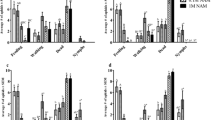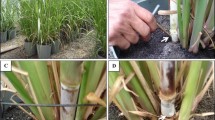Abstract
Gamma-aminobutyrate (GABA) is a ubiquitous four-carbon, non-protein amino acid synthesized by glutamate decarboxylase. Previous research suggests that the endogenous synthesis of GABA, a naturally occurring inhibitory neurotransmitter at neuromuscular junctions, serves as a plant resistance mechanism against invertebrate pests. In this study, two homozygous transgenic tobacco lines constitutively overexpressing a single copy of a full-length chimeric glutamate decarboxylase cDNA and possessing enhanced capacity for GABA accumulation (GAD plants), a homozygous transgenic line lacking the gene insert, and wild-type tobacco were employed. Tobacco budworm larvae were presented with plantattached wild type and transgenic leaves for 4 hr in a feeding preference study. Larvae consumed six to twelve times more leaf tissue from wild-type plants than from GAD plants. These results suggest that leaf GABA accumulation, which is known to occur in response to insect larval walking and feeding, represents a rapidly deployed localresistance mechanism.
Similar content being viewed by others
References
Bown, A. W. and Shelp, B. J. 1997. The metabolismand functions of 4-aminobutyric acid. Plant Physiol. 28:1–5.
Bown, A. W., Hall, D. E., and Macgregor, K. B. 2002. Insect footsteps on leaves stimulate the accumulation of 4-aminobutyrate and can be visualized through increased chlorophyll fluorescence and superoxide production. Plant Physiol. 129:1430–1434.
Casida, J. E. 1993. Insecticide action at the GABA-gated chloride channel: Recognition, progress and prospects. Arch.Insect Biochem. Physiol. 22:13–23.
Hosie, A. M., Aronstein, K., Sattelle, D. B., and French-Constant, R. H. 1997. Molecularbiology of insect neuronal GABA receptors. Tr. Neurosci. 20:578–583.
Irving, S. N., Osborne, M. P., and Andwilson, R. G. 1979. Studies on L-glutamate in insect haemolymph. I. Effect of injected L-glutamate. Physiol. Entomol. 4:139–146.
Kessler, A. and Baldwin, I. T. 2002. Plant responses to insect herbivory: The emerging molecularanalysis. Annu. Rev.Plant Biol. 53:299–328.
McLean, M. D., Yevtushenko, D. P., Deschene, A., Van cauwenberghe, O. R., Makhmoudova, A., Potter, J. W., Bown, A. W., and Shelp, B. J. 2003. Overexpression of glutamate decarboxylase in transgenic tobacco plants confers resistance to the northern root-knot nematode. Mol.Breed. 11:277–285.
Ramputh, A. and Bown, A. W. 1996. Rapid gamma-aminobutyric acid synthesis and the inhibition of the growth and development of oblique-banded leaf roller larvae. Plant Physiol. 111:1349–1352.
Serraj, R., Shelp, B. J., and Sinclair, T. R. 1998. Accumulation of ?-aminobutyric acid in nodulated soybean in responseto drought stress. Physiol. Plant. 102:79–86.
Wallace, W., Secor, J., and Scrhader, L. E. 1984. Rapid accumulation of gammaaminobutyric acid and alanine in soybean leaves in response to an abrupt transfer to low temperature, darkness, or mechanical manipulation. Plant Physiol. 75:170–175.
Author information
Authors and Affiliations
Corresponding author
Rights and permissions
About this article
Cite this article
MacGregor, K.B., Shelp, B.J., Peiris, S. et al. Overexpression of Glutamate Decarboxylase in Transgenic Tobacco Plants Deters Feeding by Phytophagous Insect Larvae. J Chem Ecol 29, 2177–2182 (2003). https://doi.org/10.1023/A:1025650914947
Issue Date:
DOI: https://doi.org/10.1023/A:1025650914947




